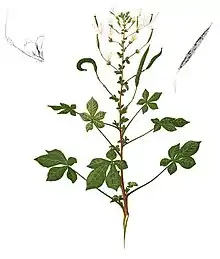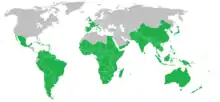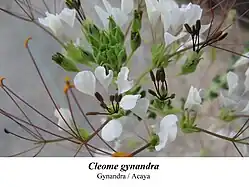Cleome gynandra
Cleome gynandra is a species of Cleome that is used as a green vegetable. It is known by many common names including Shona cabbage,[3] African cabbage, spiderwisp, cat's whiskers,[4] chinsaga, maman and stinkweed.[5] It is an annual wildflower native to Africa but has become widespread in many tropical and sub-tropical parts of the world.[6] It is an erect, branching plant generally between 25 cm and 60 cm tall. Its sparse leaves are each made up of 3–5 oval-shaped leaflets. The flowers are white, sometimes changing to rose pink as they age.[7] The seed is a brown 1.5 mm diameter sphere. The leaves and flowers are both edible. The leaves have a strong bitter, sometimes peppery flavor similar to mustard greens.
| Cleome gynandra | |
|---|---|
 | |
| Scientific classification | |
| Kingdom: | Plantae |
| Clade: | Tracheophytes |
| Clade: | Angiosperms |
| Clade: | Eudicots |
| Clade: | Rosids |
| Order: | Brassicales |
| Family: | Cleomaceae |
| Genus: | Cleome |
| Species: | C. gynandra |
| Binomial name | |
| Cleome gynandra | |
 | |
| world range[1] | |
| Synonyms[2] | |
| |
Uses

Typically, the leaves and shoots are eaten boiled or in stews. The leaves are often eaten in Sub-Saharan Africa, where they are often dried for storage, then cooked with milk or butter to reduce its bitter taste.[8] In Uganda and Tanzania, the leaves are cooked with groundnut paste.
The plant is useful for intercropping due to its insect repellent properties.[9][10]
In Thailand and Malaysia, the leaves are a popular food item fermented with rice water as a pickle known as phak sian dong.[11] The same pickle is also eaten in the northern states of Malaysia, and is known as jeruk maman. The state of Negeri Sembilan specializes in rendang maman, where the leaves are braised in spiced coconut milk for a long period of time to achieve the desirable crisp and texture.
Cleome gynandra is high in beta-carotene, folic acid, ascorbic acid and calcium. It also contains vitamin E, iron, and oxalic acid. Generally, the leaves are about 4.0% protein. The leaves also have antioxidative properties that can help with inflammatory diseases.[6] Because of its anti-inflammatory properties, it is sometimes used as a medicinal herb.[12]
Ecology
It is an annual wildflower native to Africa but has naturalized across tropic and sub-tropical regions across Asia.[6] It grows well in disturbed, well-drained soils, but is also drought-tolerant. It does not tolerate cold temperatures well, and is frost-tender.
Cleome gynandra is considered an invasive weed in many places in the U.S.[13] and elsewhere in the Pacific.[14]
Biochemistry
Cleome gynandra uses NAD-malic enzyme type C4 photosynthesis and has the characteristic traits associated with this, including changes in leaf biochemistry, cell biology and development. The family Cleomaceae is relatively close to Brassicaceae with Arabidopsis thaliana (a C3 photosynthetic plant) and therefore offers comparison with this well studied model organism.[15] The C4 pathway in this species evolved independently from two other C4 Cleome species, C. angustifolia and C. oxalidea.[16]
References
- "Cleome gynandra - L." pfaf.org. 1996–2012. Retrieved 19 March 2019.
- "The Plant List: A Working List of All Plant Species". Retrieved January 26, 2014.
- "dict.cc dictionary :: Shona cabbage :: German-English translation". www.dict.cc. Retrieved 2016-07-19.
- "Gynandropsis gynandra". Germplasm Resources Information Network. Agricultural Research Service, United States Department of Agriculture. Retrieved 28 July 2015.
- "Natural pesticides from a common weed launched Kaua'i's pesticide furor". 17 November 2015.
- "Spider plant (Cleome gynandra) – World Vegetable Center". World Vegetable Center. 2016-04-25. Retrieved 2016-07-19.
- Cleome gynandra L. entry in PlantZAfrica.com database
- Pieroni, Andrea (2005). Prance, Ghillean; Nesbitt, Mark (eds.). The Cultural History of Plants. Routledge. p. 30. ISBN 0415927463.
- Engels, Johannes M.M. Engels (2002). Managing plant genetic diversity. Oxon, UK: CABI Pub. p. 332. ISBN 0-85199-522-5.
- "Cultivating cleome". Farmer's Weekly. 8 September 2020. Retrieved 17 October 2020.
- ผักเสี้ยน สรรพคุณและประโยชน์ของผักเสี้ยน 29 ข้อ !
- "Cleome gynandra African Spider Flower, Spiderwisp PFAF Plant Database". www.pfaf.org. Retrieved 2016-07-19.
- USDA-NRCS: Invasive and noxious weeds
- Cleome gynandra: Plant threats to Pacific ecosystems (Pacific Island Ecosystems at Risk project (PIER))
- Marshall, D.M.; Muhaidat, R.; Brown, N.J.; Liu, Z.; Stanley, S.; Griffiths, H.; Sage, R.F.; Hibberd, J.M. (2007). "Cleome, a genus closely related to Arabidopsis, contains species spanning a developmental progression from C3 to C4 photosynthesis". The Plant Journal. 51 (5): 886–896. doi:10.1111/j.1365-313X.2007.03188.x. ISSN 0960-7412. PMID 17692080.

- Feodorova, T.A.; Voznesenskaya, E.V.; Edwards, G.E.; Roalson, E.H. (2010). "Biogeographic patterns of diversification and the origins of C4 in Cleome (Cleomaceae)" (PDF). Systematic Botany. 35 (4): 811–826. doi:10.1600/036364410X539880. ISSN 0363-6445. S2CID 84983697. Retrieved 16 June 2016.